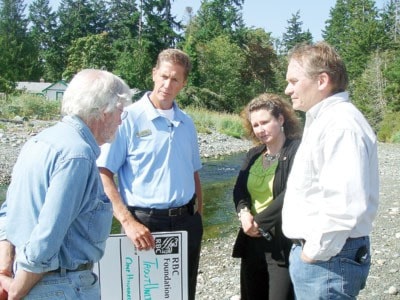The fishing was hot at the mouth of the Nile Creek in Qualicum Bay Wednesday, August 31, but a small group of people who gathered there just before noon were more impressed with a cheque for $125,000 that was presented to the Nile Creek Enhancement Society (NCES) for its ongoing efforts to restore and enhance habitat in Bowser and Qualicum Bay area creeks.
The donation came from the Royal Bank of Canada’s (RBC) 50 million dollar Blue Water fund and will be used to launch phase two of the Nile Creek—Qualicum Bay Watershed Renewal Program.
The Blue Water Project has two main themes; watershed protection and enhancement and access to safe drinking water, and with those goals in mind, RBC Regional Vice-President for North Vancouver Island Mark Lovick handed over the big cheque to NCES President Ken Kirkby.
Also on hand for the funding announcement were members from Trout Unlimited Canada, one of the many partners involved IN a five-year program to restore sea-run cutthroat trout and to renew the health of the small watersheds that flow into Qualicum Bay.
Kirkby, who helped initiate the restoration of Nile Creek with local volunteers in the 1990s said NCES has come a long way from 20 years ago when the creek was dead.
He said the creek once known as “The Pink River” is again teeming with fish and is a thriving tourist attraction. He declared the transformation of the creek a great example of stewardship and many people have come together to make Nile Creek a very happy upbeat story.
“The building of a community is everybody’s business; the sustaining of the systems that we have here; the rivers, the estuaries and the oceans cannot be sustained without community,” Kirkby said.
He said with RBC joining the cause an incredible partnership has been formed.
“Simply put, the bank put its mouth where its money is and together we will be able to do things that I think will be looked at kindly by the generations to come.”
Lovick agreed, saying the project is going to build on a very successful phase one which has been generously supported by grants from the Blue Water fund.
In that project they began an assessment to try to understand the water resources and ground water systems as well as the habitat and animal communities found in the area.
Lovick said research has found the area extremely important and, geologically, the watersheds are some of the most unique on Vancouver Island. He added the area has some of the most groundwater-rich resources on the island and therefore requires protection.
“Ultimately what we are trying to do is create tools for the local community so they are more informed and better understand their water resources and are more active in protecting their own water resources because ultimately it is a resource of the people who live here not us.”
Jack Imhof, M.Sc., National Biologist and Conservation Ecology Director for Trout Unlimited Canada said TUC prides itself on its ability to work with partners and local communities to deliver sound work on the ground.
Since their formation in 1972, TUC has developed national expertise in watershed, river and stream restoration with a mandate to conserve, protect and restore Canada’s freshwater ecosystems.
“Our fundamental policy is to conserve and restore clean, cold water … the ultimate product of a healthy watershed: benefiting aquatic life and people as well,” said Imhof.
He added it is essential they continue to work in collaboration and partnership with the local community because ultimately these watersheds are the resource of those that live here.
“We will continue to build on the fine work and restoration model developed by the Nile Creek Enhancement Society. We will continue to work with the local community, VIU students and scientists and government agencies to improve our understanding of the characteristics of the water and aquatic resources of these watersheds and to rehabilitate damaged components of these watersheds,” Imhof said.
He stated that a better understanding of the groundwater and surface water system in these watersheds will provide a tool for the community to ensure the sustainability of their water resources and the aquatic life in their watersheds.
reporter@pqbnews.com
